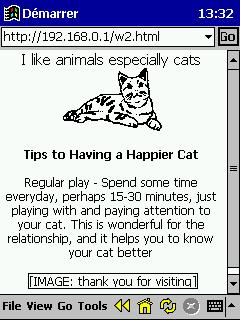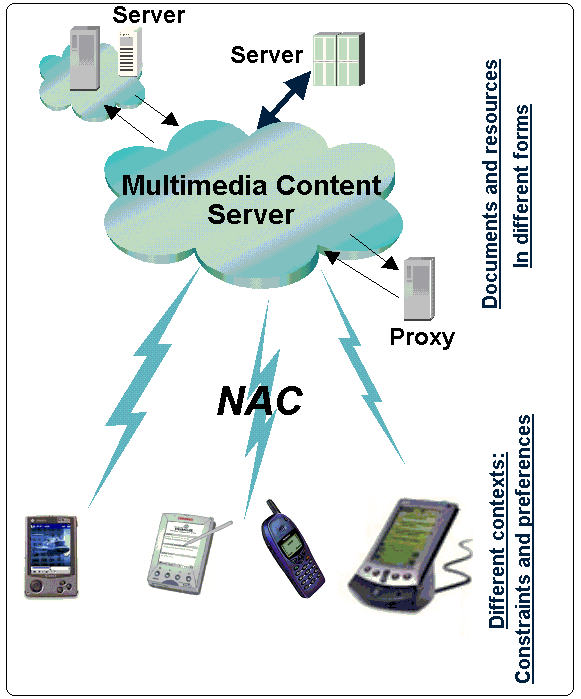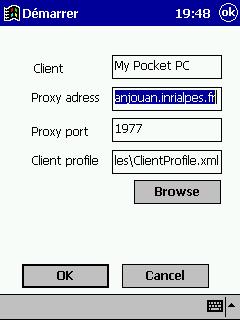NAC: A Basic Core for the Adaptation and Negotiation of Multimedia ServicesTayeb
Lemlouma and Nabil Layaïda
|
||
|
|
||
 |
||
| What
is the NAC architecture? Learn more about NAC |
||||||||||
| Another
fixed target is to make the core extensible for other models and kind
of adaptation. Hence, the same architecture can be reused to meet the
needs of other particular environments with their proper specifications. The implemented core allows different players to use a multimedia content which is adapted automatically to their preferences and capacities. Client profiles are declared in a CC/PP structure stored in XML documents and can be modified at anytime. NAC is designed to be not limitted to any particular kinde of services (HTML, SMIL, etc.) or protocoles (HTTP, WAP, etc.), this is why the framework can support the concept of "protocol adaptation", for example in the case where the original request is written in HTTP and the target request is a WAP request one. NAC supports actually the HTTP protocol in services delivery and the exchange of requests. It can adapt HTML and SMIL services according to the constraints of the end user. The proposed core doesn't make any assumption on the existing platform. Indeed, to use our solution, players must only point to the proxy used by our core; services will be then adapted automatically. The architecture of NAC is flexible to be used at any particular system, and enriched by transformation programs or style sheets to meet particular needs. |
||||||||||
| This repository describes real devices. Many recent models in today's mobile market are included. Take a look on the repository | ||||||||||
|
The
Adaptation and Negotiation Module (ANM) Proxy
|
The
Last Version of ANM
|
|||||||||
|
||||||||||
|
||||||||||
 |
 |
|||||||||
|
PocketSMIL
Player
|
Last
Version of PocketSMIL Player
|
|||||||||
| The
universal profiling schema (UPS) was defined to have a central role in
the generation of adapted content. UPS identifies three main categories
of contexts: the client category, the server category and the network
category. From the content side, the server category includes the document
instance profile that describes the document characteristics and functionalities.
It includes also the resource profile that describes a used media resource
and the adaptation method profile that describes an available adaptation
method that exist in the server or the proxy side. Take a look on UPS and The UPSProfiles Package |
||||||||||
 |
||||||||||
|
Example
of filtering: HTML filtering (filter images from the HTML content)
|
||||||||||
|
HTML
to WML Structural Transformation
|
||||||||||
 |
||||||||||
|
The
content (w2.html) received from the proxy using an IE client
|
The
content (w2.html) received from the proxy using a WAP client
|
|||||||||
 |
||||||||||
|
The
content (w.html) received from the proxy using an IE client
|
The
content (w.html) received from the proxy using a WAP client
|
|||||||||
 |
||||||||||
|
The
adaptation of a SMIL document
|
||||||||||
|
Using a remote entity for the adaptation
|
||||||||||
|
An
application of the daptation: Text to SMS
|
||||||||||
|
Images
resizing application
|
||||||||||
 |
||||||||||
|
Images
resizing application: Here the proxy resize images used by HTML documents
|
||||||||||
|
Adding
some new content to the original requested document
|
||||||||||
|
Generating
video presentations from SMIL sepcifications (learn
more about this application)
|
||||||||||
|
||||||||||
 |
||||||||||
|
SOAP
Architecture
|
||||||||||
|
Evaluation
of XQuery Delay
|
Evaluation
of RPC calls
|
|||||||||
|
Evaluation
of UPS components exctraction
|
||||||||||
|
|
||||||||||
| For further information about NAC, please mail us at : Tayeb.Lemlouma@inrialpes.fr | ||||||||||
|
|
||||||||||
|
Author:
Tayeb Lemlouma
Last revised date: 2003/09/20 |
||||||||||




























